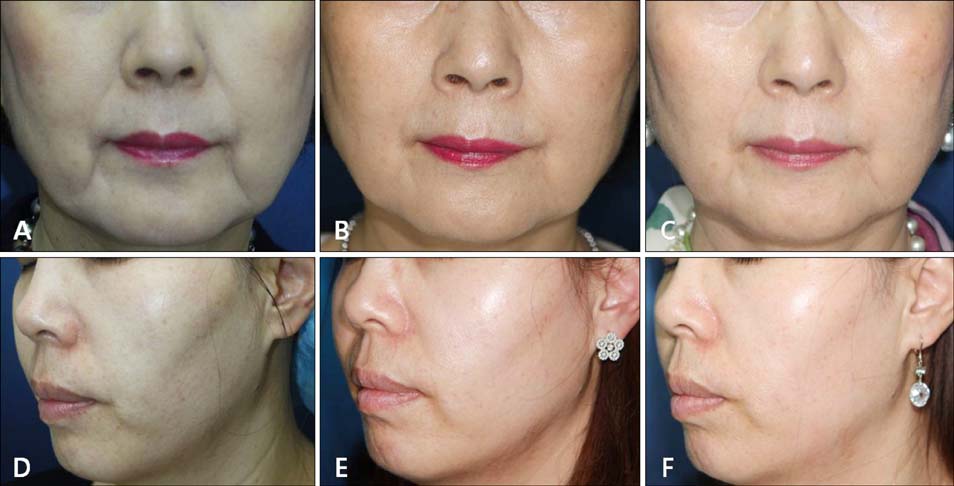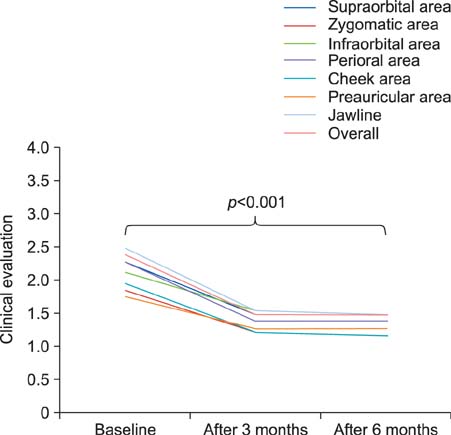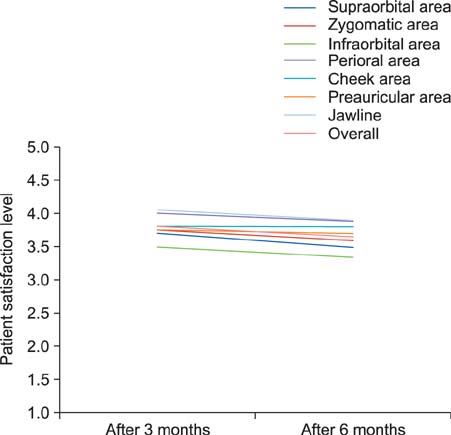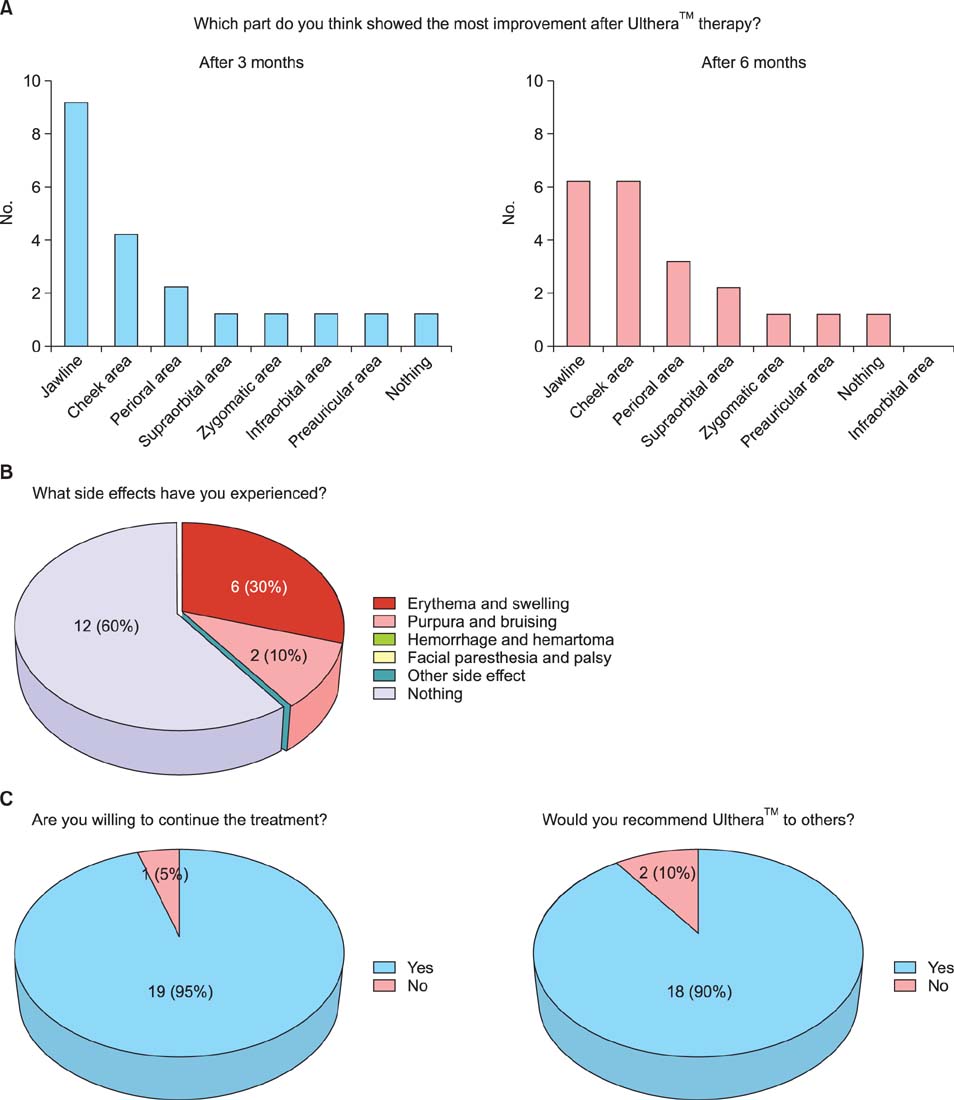Ann Dermatol.
2015 Dec;27(6):688-693. 10.5021/ad.2015.27.6.688.
High-Intensity Focused Ultrasound for the Treatment of Wrinkles and Skin Laxity in Seven Different Facial Areas
- Affiliations
-
- 1Department of Dermatology, Hanyang University Seoul Hospital, Hanyang University College of Medicine, Seoul, Korea. drko0303@hanyang.ac.kr
- 2Toomyung Dermatology, Seoul, Korea.
- KMID: 2157444
- DOI: http://doi.org/10.5021/ad.2015.27.6.688
Abstract
- BACKGROUND
High-intensity focused ultrasound (HIFU) treatment has recently emerged in response to the increasing demand for noninvasive procedures for skin lifting and tightening.
OBJECTIVE
This study was aimed at evaluating the clinical efficacy of and patient satisfaction with HIFU treatment for wrinkles and laxity in seven different areas of the face in Asian skin.
METHODS
Twenty Korean patients with facial wrinkle and laxity were analyzed after a single session of HIFU treatment. Two independent, blinded clinicians evaluated the clinical improvement in seven areas of the face by comparison of standardized photographs obtained before, and at 3 and 6 months after treatment. Assessment of subjective satisfaction and adverse effects of treatment were done by using questionnaires.
RESULTS
The physicians' evaluation and patients' satisfaction with the clinical effects of HIFU in each area were similar regardless of the number of treatment shots. The jawline, cheek, and perioral areas were the sites where HIFU was most effective, in decreasing order. The adverse effects included erythema and swelling in six cases, and purpura and bruising in two cases. However, the adverse effects were mild and transient.
CONCLUSION
HIFU could be a safe, effective, and noninvasive procedure that can be used to improve facial wrinkles and skin laxity in Asian skin. It is particularly effective for clinical improvement in the jawline, cheek, and perioral areas.
Keyword
MeSH Terms
Figure
Reference
-
1. Lee YB, Eun YS, Lee JH, Cheon MS, Cho BK, Park HJ. Effects of multi-polar radiofrequency and pulsed electromagnetic field treatment in Koreans: case series and survey study. J Dermatolog Treat. 2014; 25:310–313.
Article2. Shapiro SD, Eros Y, Abrahami Y, Leviav A. Evaluation of safety and efficacy of the TriPollar technology for treatment of wrinkles. Lasers Surg Med. 2012; 44:453–458.
Article3. Bloom BS, Emer J, Goldberg DJ. Assessment of safety and efficacy of a bipolar fractionated radiofrequency device in the treatment of photodamaged skin. J Cosmet Laser Ther. 2012; 14:208–211.
Article4. Lee HS, Lee DH, Won CH, Chang HW, Kwon HH, Kim KH, et al. Fractional rejuvenation using a novel bipolar radiofrequency system in Asian skin. Dermatol Surg. 2011; 37:1611–1619.
Article5. Kleinerman R, Whang TB, Bard RL, Marmur ES. Ultrasound in dermatology: principles and applications. J Am Acad Dermatol. 2012; 67:478–487.
Article6. Suh DH, Oh YJ, Lee SJ, Rho JH, Song KY, Kim NI, et al. A intense-focused ultrasound tightening for the treatment of infraorbital laxity. J Cosmet Laser Ther. 2012; 14:290–295.
Article7. White WM, Makin IR, Barthe PG, Slayton MH, Gliklich RE. Selective creation of thermal injury zones in the superficial musculoaponeurotic system using intense ultrasound therapy: a new target for noninvasive facial rejuvenation. Arch Facial Plast Surg. 2007; 9:22–29.
Article8. Alam M, White LE, Martin N, Witherspoon J, Yoo S, West DP. Ultrasound tightening of facial and neck skin: a raterblinded prospective cohort study. J Am Acad Dermatol. 2010; 62:262–269.
Article9. Suh DH, Shin MK, Lee SJ, Rho JH, Lee MH, Kim NI, et al. Intense focused ultrasound tightening in Asian skin: clinical and pathologic results. Dermatol Surg. 2011; 37:1595–1602.
Article10. Chan NP, Shek SY, Yu CS, Ho SG, Yeung CK, Chan HH. Safety study of transcutaneous focused ultrasound for noninvasive skin tightening in Asians. Lasers Surg Med. 2011; 43:366–375.
Article11. Brobst RW, Ferguson M, Perkins SW. Ulthera: initial and six month results. Facial Plast Surg Clin North Am. 2012; 20:163–176.
Article12. Chung JH, Lee SH, Youn CS, Park BJ, Kim KH, Park KC, et al. Cutaneous photodamage in Koreans: influence of sex, sun exposure, smoking, and skin color. Arch Dermatol. 2001; 137:1043–1051.13. Alster TS, Tanzi EL. Noninvasive lifting of arm, thigh, and knee skin with transcutaneous intense focused ultrasound. Dermatol Surg. 2012; 38:754–759.
Article
- Full Text Links
- Actions
-
Cited
- CITED
-
- Close
- Share
- Similar articles
-
- Skin tightening effecacy and safety: high-intensity focused ultrasound alone or in combination with monopolar radiofreqeuncy treatment in Republic of Korea: retrospective clinical study
- Facial Rejuvenation with High-intensity Focused Ultrasonography
- Glabellar wrinkle improvement after forehead and periorbital micro-focused ultrasound treatment in Republic of Korea: a case report
- Treatment of Skin Laxity and Facial Wrinkles with Combinationof Radiofrequency and Infrared Light
- Clinical utility of the 2-line high-intensity focused ultrasound for skin tightening in Republic of Korea: retrospective clinical study





